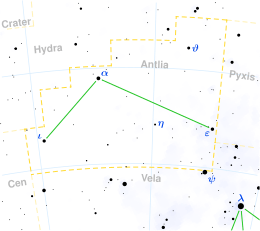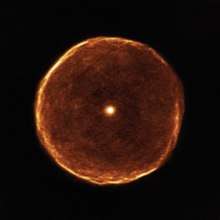U Antliae
 | |
| Observation data Epoch J2000 Equinox J2000 | |
|---|---|
| Constellation | Antlia |
| Right ascension | 10h 35m 12.852s[1] |
| Declination | −39° 33′ 45.32″[1] |
| Apparent magnitude (V) | 5.27 - 6.04[2] |
| Characteristics | |
| Spectral type | C5,3[3] |
| U−B color index | 7.10[4] |
| B−V color index | 2.84[4] |
| Variable type | LB[5] |
| Astrometry | |
| Radial velocity (Rv) | 41.00[6] km/s |
| Proper motion (μ) | RA: −31.02 ± 0.56[1] mas/yr Dec.: 3.50 ± 0.53[1] mas/yr |
| Parallax (π) | 3.73 ± 0.54[1] mas |
| Distance | approx. 900 ly (approx. 270 pc) |
| Absolute magnitude (MV) | −5.22[7] |
| Details | |
| Radius | 325[8] R☉ |
| Luminosity | 8,000[9] L☉ |
| Temperature | 2,800[9] K |
| Other designations | |
| Database references | |
| SIMBAD | data |
Coordinates: ![]()

ALMA image of the dust shells around U Antliae
U Antliae (U Ant) is a star in the constellation Antlia.
U Antliae is a red C-type carbon star and is an irregular variable star that varies between magnitudes 5.27 and 6.04. Approximately 900 light years from Earth, it shines with a luminosity approximately 8,000 times that of the Sun and has a surface temperature of 2,800 K. It is surrounded by two shells of dust, thought to have been ejected 14,000 and 10,000 years ago.[10]
References
- 1 2 3 4 5 van Leeuwen, F. (2007). "Validation of the new Hipparcos reduction". Astronomy and Astrophysics. 474 (2): 653–664. arXiv:0708.1752. Bibcode:2007A&A...474..653V. doi:10.1051/0004-6361:20078357. Vizier catalog entry
- ↑ Otero, Sebastian (3 November 2011). "U Antliae". AAVSO Website. American Association of Variable Star Observers. Retrieved 25 July 2014.
- ↑ Yamashita, Y. (1975). "The C-classification of spectra of carbon stars. II". Tokyo. 15: 47. Bibcode:1975AnTok..15...47Y.
- 1 2 Ducati, J. R. (2002). "VizieR Online Data Catalog: Catalogue of Stellar Photometry in Johnson's 11-color system". CDS/ADC Collection of Electronic Catalogues. 2237. Bibcode:2002yCat.2237....0D.
- ↑ Samus, N. N.; Durlevich, O. V.; et al. (2009). "VizieR Online Data Catalog: General Catalogue of Variable Stars (Samus+ 2007-2013)". VizieR On-line Data Catalog: B/gcvs. Originally published in: 2009yCat....102025S. 1. Bibcode:2009yCat....102025S.
- ↑ Gontcharov, G. A. (2006). "Pulkovo Compilation of Radial Velocities for 35 495 Hipparcos stars in a common system". Astronomy Letters. 32 (11): 759. arXiv:1606.08053. Bibcode:2006AstL...32..759G. doi:10.1134/S1063773706110065.
- ↑ Guandalini, R.; Cristallo, S. (2013). "Luminosities of carbon-rich asymptotic giant branch stars in the Milky Way". Astronomy & Astrophysics. 555: 7. arXiv:1305.4203. Bibcode:2013A&A...555A.120G. doi:10.1051/0004-6361/201321225. A120.
- ↑ De Beck, E.; Decin, L.; De Koter, A.; Justtanont, K.; Verhoelst, T.; Kemper, F.; Menten, K. M. (2010). "Probing the mass-loss history of AGB and red supergiant stars from CO rotational line profiles. II. CO line survey of evolved stars: Derivation of mass-loss rate formulae". Astronomy and Astrophysics. 523: A18. arXiv:1008.1083. Bibcode:2010A&A...523A..18D. doi:10.1051/0004-6361/200913771.
- 1 2 Kerschbaum, F.; Ladjal, D.; Ottensamer, R.; Groenewegen, M. A. T.; Mecina, M.; Blommaert, J. A. D. L.; Baumann, B.; Decin, L.; Vandenbussche, B.; Waelkens, C.; Posch, T.; Huygen, E.; De Meester, W.; Regibo, S.; Royer, P.; Exter, K.; Jean, C. (2010). "The detached dust shells of AQ Andromedae, U Antliae, and TT Cygni". Astronomy and Astrophysics. 518: L140. arXiv:1005.2689. Bibcode:2010A&A...518L.140K. doi:10.1051/0004-6361/201014633.
- ↑ Izumiura, H.; Waters, L. B. F. M.; de Jong, T.; Loup, C.; Bontekoe, Tj. R.; Kester, D. J. M. (1997). "A double dust shell surrounding the carbon star U Antliae". Astronomy and Astrophysics. 323: 449–60. Bibcode:1997A&A...323..449I.
This article is issued from
Wikipedia.
The text is licensed under Creative Commons - Attribution - Sharealike.
Additional terms may apply for the media files.